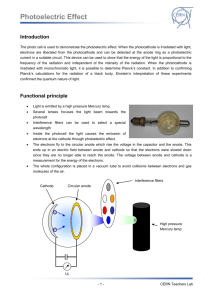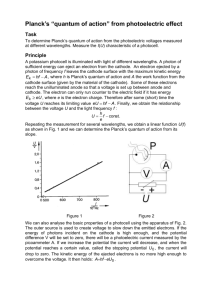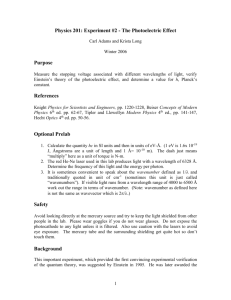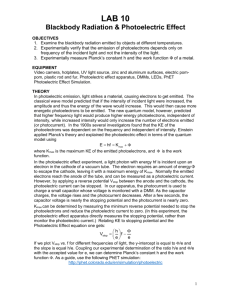Photoelectric Effect
advertisement
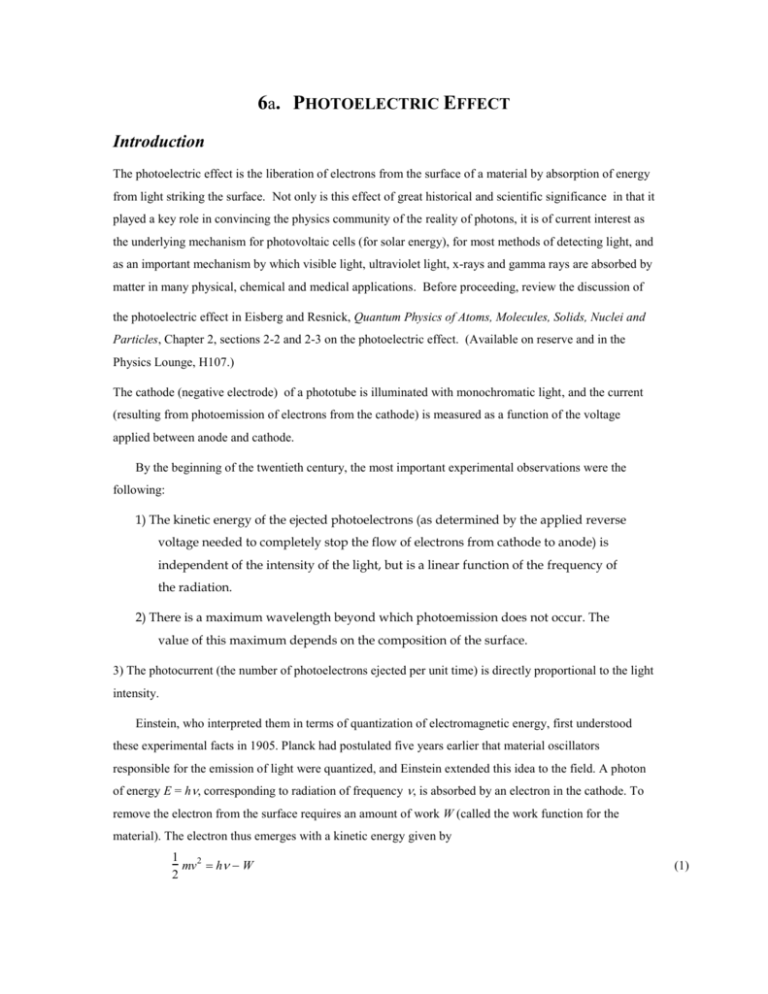
6a. PHOTOELECTRIC EFFECT Introduction The photoelectric effect is the liberation of electrons from the surface of a material by absorption of energy from light striking the surface. Not only is this effect of great historical and scientific significance in that it played a key role in convincing the physics community of the reality of photons, it is of current interest as the underlying mechanism for photovoltaic cells (for solar energy), for most methods of detecting light, and as an important mechanism by which visible light, ultraviolet light, x-rays and gamma rays are absorbed by matter in many physical, chemical and medical applications. Before proceeding, review the discussion of the photoelectric effect in Eisberg and Resnick, Quantum Physics of Atoms, Molecules, Solids, Nuclei and Particles, Chapter 2, sections 2-2 and 2-3 on the photoelectric effect. (Available on reserve and in the Physics Lounge, H107.) The cathode (negative electrode) of a phototube is illuminated with monochromatic light, and the current (resulting from photoemission of electrons from the cathode) is measured as a function of the voltage applied between anode and cathode. By the beginning of the twentieth century, the most important experimental observations were the following: 1) The kinetic energy of the ejected photoelectrons (as determined by the applied reverse voltage needed to completely stop the flow of electrons from cathode to anode) is independent of the intensity of the light, but is a linear function of the frequency of the radiation. 2) There is a maximum wavelength beyond which photoemission does not occur. The value of this maximum depends on the composition of the surface. 3) The photocurrent (the number of photoelectrons ejected per unit time) is directly proportional to the light intensity. Einstein, who interpreted them in terms of quantization of electromagnetic energy, first understood these experimental facts in 1905. Planck had postulated five years earlier that material oscillators responsible for the emission of light were quantized, and Einstein extended this idea to the field. A photon of energy E = h, corresponding to radiation of frequency , is absorbed by an electron in the cathode. To remove the electron from the surface requires an amount of work W (called the work function for the material). The electron thus emerges with a kinetic energy given by 1 2 mv h W 2 (1) where m is the mass of the electron and v is its velocity. Increasing the intensity increases the number of photons, and thus the number of photoelectrons, but not the energy of each electron. Correspondingly, the negative potential, Vo, needed to stop the electron flow is determined by the fact that the corresponding potential energy, eVo, must equal the electron's initial kinetic energy. Hence, the “stopping potential,” Vo, is given by eV 0 h W (2) That is, Vo is a linear function of frequency, as observed experimentally. Hence, if Vo is plotted as a function of , one will obtain a straight line as shown in Figure 2. The slope of the line is h/e, the quantity to be determined in this experiment. The intersection of this curve for Vo = 0 yields the cut-off frequency o = W/h. The significance of this frequency, , is that light of frequencies less than will have insufficient energy to liberate electrons, i.e., the energies of the incident photons will be less than the work function, W. Figure 2: Determination of h/e. The earliest experiments on the photoelectric effect were performed with alkali-metal cathode surfaces because of their low work function and relatively high photoelectric efficiency (ratio of electrons emitted to photons absorbed). Even so, the efficiency was only about 0.1%, and photocurrents produced by moderate light intensities were in the microampere range. Experimental Procedure A mercury arc lamp serves as a convenient source of a wide range of spectral lines for studying the photoelectric effect. Although the relative intensity of the lines depends on the design of the source, the strongest lines are those listed in Table 1. These lines, plus a low intensity continuum, are present in the radiation emitted by the mercury lamp. The apparatus is shown in Figure 3. Individual lines can be separated by a diffraction grating mounted in front of the lamp. The photodetector is then rotated to different angular positions to illuminate the photocathode with specific spectral lines. Special filters are provided for the green and yellow spectral lines to remove stray light of other frequencies that may be present. A variable neutral density filter is also provided to allow you to change the light intensity. Our apparatus take advantage of technology not available in Einstein’s day, namely high impedance operational amplifiers (about 1015 ohms!), which allow the measurement of a small voltage without actually drawing any significant current. The circuit is shown in Fig. 4. The anode of the photodiode is connected to one side of a small capacitor which becomes charged as a result of the photocurrent, until the voltage is just sufficient to stop any further flow of charge. (The capacitor plate is the circular device to the right of the photodiode.) The opposite “plate” of the capacitor is grounded (not shown). The capacitor is connected to the non-inverting input of an operational amplifier, which is connected in the “unity gain voltage follower” configuration. You should remember from your earlier op-amp experiment, that when there is no resistor in the feedback loop, the output voltage of the op-amp is equal to the input voltage, so the output gives the capacitor voltage directly. Figure 3: Photoelectric Effect Apparatus: detector is at left and mercury vapor lamp is at the right. (Pasco Scientific Manual) Figure 4 Schematic circuit diagram for the photoelectric effect apparatus. (The actual circuit is more complicated than this simplified diagram indicates.) (Pasco Scientific) Prelab question: Why bother to use the op-amp, instead of simply measuring the capacitor voltage directly with a DMM? Hint: Think about impedances. Note the pushbutton that allows the capacitor to be discharged. The charging time when it is released is a measure of the photocurrent, which can depend on the light intensity. Mercury Spectral Lines Wavelength (Å) Color 5790.65 Yellow (note it’s indistinguishably close to the other line) 5769.59 Yellow (note it’s indistinguishably close to the other line) 5460.74 green 4358.35 blue 4046.56 violet 3650.15 near ultraviolet (but still visible) Table 1: The most common spectral lines for Hg. Note that you will use the average wavelength of the two yellow lines. You will not use the red continuum part of the spectrum. Experimental Procedure: Important Note: If at any time you get results that indicate your intensities are either not changing or behaving in a fashion inconsistent with expectations, check with your instructors. Your detector box may need to be checked for internal alignment. (See the h/e Experiment Manual, Pasco Scientific for details on how to do this.) 1) Turn on the mercury lamp and allow five minutes for it to stabilize before taking measurements. 2) Make sure that the photodetector is properly aligned so the light that passes through the slit actually hits the detector. Be very careful to check this alignment throughout your experiment. (To do this, pivot the round black tube in front of the detector out of the way. Look at the white covering of the photodetector. It has a slot cut into it so the light can get inside to the detector. If the light is not hitting this slot, rotate the entire detector head until it does, then tighten the screw holding the detector in place and carefully rotate the black tube back in place. Note that your detector will look rotated, not at right angles to the rays from the mercury lamp. Be careful not to bump the alignment after this!) Also, watch out for aberrant behavior that may indicate that the power supply battery needs to be replaced. The battery voltages should each read over 9.0 Volts, since their ability to source current drops rapidly once either even reaches 9.0 V! Make sure you use antistatic grounding straps throughout your measurements, since the measurements are static sensitive. 3) Pick a spectral line. If it is green or yellow, be sure to use the filter provided. Vary the light intensity using the neutral density filter, starting with the darkest for the lowest intensity. For this one wavelength, study the stopping potential and approximate charging time for various light intensities. To do this, use an oscilloscope to capture the voltage output from your PE unit on Channel 1 vs. time. Set your oscilloscope on the 1V scale and approximately 200msec time scale. On the Triggering menu at right, select Source: 1 , Mode: Single, Slope/Coupling: the icon showing an increasing slope: . You will also want to set the knob next to the Triggering Level to a small positive voltage. This sets oscilloscope to capture single shot scans of voltage vs. time, whenever you press RUN and the voltage on Channel 1 exceeds the triggering level. To do a run, first ERASE the oscilloscope screen, the press RUN and press the reset button on the PE unit. (Make sure the PE unit is turned on!) It will be easiest to see the charging curve if you use the darkest neutral density filter first, and a timescale of approximately 200 msec to start. The charging time can be determined, for example, as the time required to rise to a fixed fraction of the final voltage, say (1 - e -2). This would be twice the RC time constant of the measuring circuit. PLOT the stopping potential and charging time versus light intensity using a spreadsheet program like Origin that allows error bars. Discuss the results with your instructor. You do not need to repeat these measurements for more than one spectral line. 4) You can see five colors in two orders of the mercury light spectrum. Measure the stopping potential for all the colors in each order. (The red wavelength should not be used, since it appears to be mixed in with the higher order ultraviolet lines, so its values for stopping voltage are off.) Plot the stopping potential versus frequency, and use the results to determine the Workfunction, W, and the value of h/e. Use error bars for your datapoints and get error bars for your h/e estimate to use in comparison with established values. You can do this either by using a program like Origin that can compute error bars for fitted parameters like slopes, or by eyeballing the range of slopes in agreement with your data and error bars. 5) Do a careful analysis of the experimental uncertainties, of these measured quantities. Compare h/e and W to the accepted values. (See above.) 6) Explain the operation of the detection circuit in your report or notebook.

